汉服英文介绍
- 格式:doc
- 大小:26.00 KB
- 文档页数:5
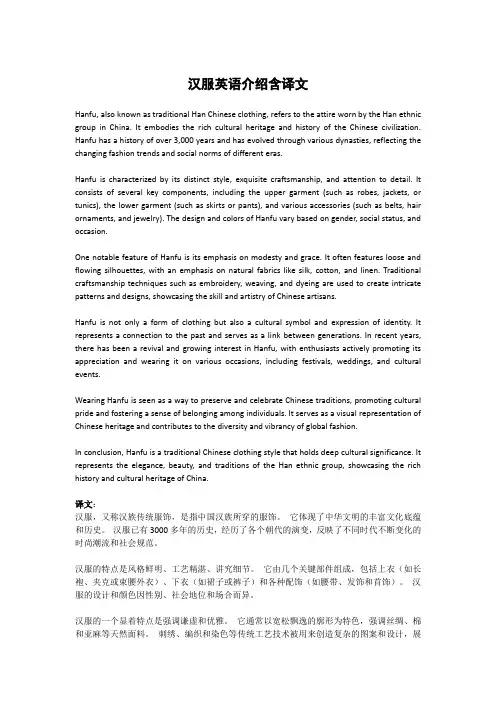
汉服英语介绍含译文Hanfu, also known as traditional Han Chinese clothing, refers to the attire worn by the Han ethnic group in China. It embodies the rich cultural heritage and history of the Chinese civilization. Hanfu has a history of over 3,000 years and has evolved through various dynasties, reflecting the changing fashion trends and social norms of different eras.Hanfu is characterized by its distinct style, exquisite craftsmanship, and attention to detail. It consists of several key components, including the upper garment (such as robes, jackets, or tunics), the lower garment (such as skirts or pants), and various accessories (such as belts, hair ornaments, and jewelry). The design and colors of Hanfu vary based on gender, social status, and occasion.One notable feature of Hanfu is its emphasis on modesty and grace. It often features loose and flowing silhouettes, with an emphasis on natural fabrics like silk, cotton, and linen. Traditional craftsmanship techniques such as embroidery, weaving, and dyeing are used to create intricate patterns and designs, showcasing the skill and artistry of Chinese artisans.Hanfu is not only a form of clothing but also a cultural symbol and expression of identity. It represents a connection to the past and serves as a link between generations. In recent years, there has been a revival and growing interest in Hanfu, with enthusiasts actively promoting its appreciation and wearing it on various occasions, including festivals, weddings, and cultural events.Wearing Hanfu is seen as a way to preserve and celebrate Chinese traditions, promoting cultural pride and fostering a sense of belonging among individuals. It serves as a visual representation of Chinese heritage and contributes to the diversity and vibrancy of global fashion.In conclusion, Hanfu is a traditional Chinese clothing style that holds deep cultural significance. It represents the elegance, beauty, and traditions of the Han ethnic group, showcasing the rich history and cultural heritage of China.译文:汉服,又称汉族传统服饰,是指中国汉族所穿的服饰。
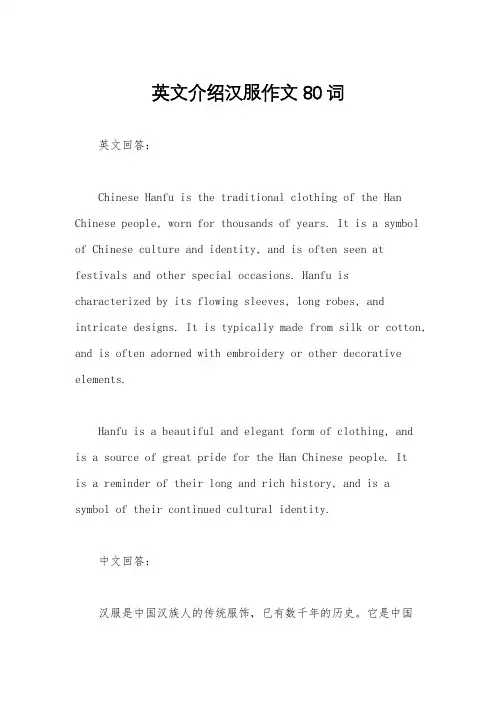
英文介绍汉服作文80词英文回答:Chinese Hanfu is the traditional clothing of the Han Chinese people, worn for thousands of years. It is a symbol of Chinese culture and identity, and is often seen at festivals and other special occasions. Hanfu is characterized by its flowing sleeves, long robes, and intricate designs. It is typically made from silk or cotton, and is often adorned with embroidery or other decorative elements.Hanfu is a beautiful and elegant form of clothing, andis a source of great pride for the Han Chinese people. Itis a reminder of their long and rich history, and is a symbol of their continued cultural identity.中文回答:汉服是中国汉族人的传统服饰,已有数千年的历史。
它是中国文化和身份的象征,经常在节日和其他特殊场合见到。
汉服的特点是宽大的袖子、长袍和精美的设计。
它通常由丝绸或棉花制成,并经常饰有刺绣或其他装饰元素。
汉服是一种美丽而优雅的服装形式,是汉族人的骄傲。
它提醒着他们悠久而丰富的历史,象征着他们延续不断的文化认同。
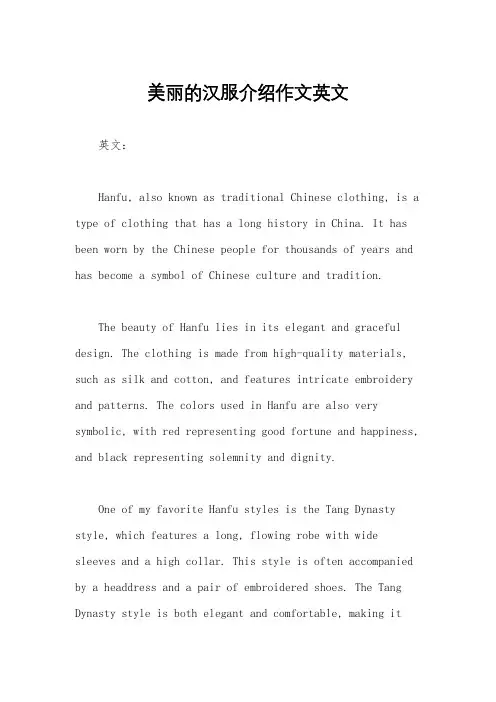
美丽的汉服介绍作文英文英文:Hanfu, also known as traditional Chinese clothing, is a type of clothing that has a long history in China. It has been worn by the Chinese people for thousands of years and has become a symbol of Chinese culture and tradition.The beauty of Hanfu lies in its elegant and graceful design. The clothing is made from high-quality materials, such as silk and cotton, and features intricate embroidery and patterns. The colors used in Hanfu are also very symbolic, with red representing good fortune and happiness, and black representing solemnity and dignity.One of my favorite Hanfu styles is the Tang Dynasty style, which features a long, flowing robe with wide sleeves and a high collar. This style is often accompanied by a headdress and a pair of embroidered shoes. The Tang Dynasty style is both elegant and comfortable, making itperfect for special occasions.Another popular Hanfu style is the Ming Dynasty style, which features a long, flowing robe with a wide belt and a high collar. This style is often accompanied by a hat and a pair of embroidered shoes. The Ming Dynasty style is more practical and comfortable for everyday wear.Overall, Hanfu is a beautiful and important part of Chinese culture. It represents the history, tradition, and elegance of the Chinese people.中文:汉服,也被称为传统的中国服装,是中国具有悠久历史的一种服饰。
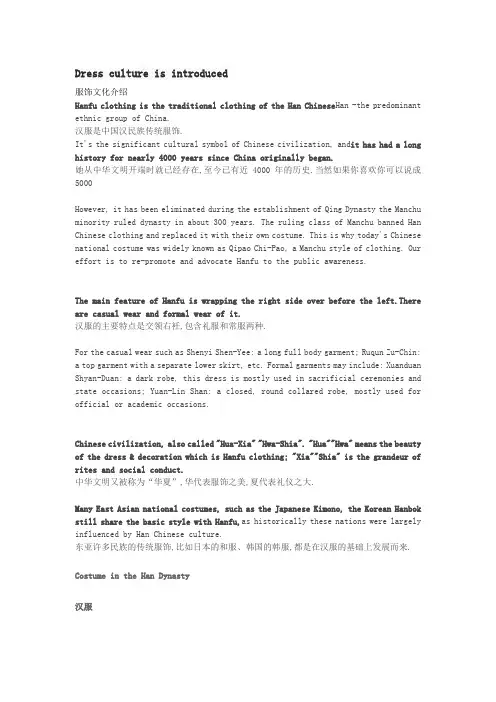
Dress culture is introduced服饰文化介绍Hanfu clothing is the traditional clothing of the Han Chinese Han -the predominant ethnic group of China.汉服是中国汉民族传统服饰.It's the significant cultural symbol of Chinese civilization, and it has had a long history for nearly 4000 years since China originally began.她从中华文明开端时就已经存在,至今已有近4000年的历史.当然如果你喜欢你可以说成5000However, it has been eliminated during the establishment of Qing Dynasty the Manchu minority ruled dynasty in about 300 years. The ruling class of Manchu banned Han Chinese clothing and replaced it with their own costume. This is why today's Chinese national costume was widely known as Qipao Chi-Pao, a Manchu style of clothing. Our effort is to re-promote and advocate Hanfu to the public awareness.The main feature of Hanfu is wrapping the right side over before the left.There are casual wear and formal wear of it.汉服的主要特点是交领右衽,包含礼服和常服两种.For the casual wear such as Shenyi Shen-Yee: a long full body garment; Ruqun Zu-Chin: a top garment with a separate lower skirt, etc. Formal garments may include: Xuanduan Shyan-Duan: a dark robe, this dress is mostly used in sacrificial ceremonies and state occasions; Yuan-Lin Shan: a closed, round collared robe, mostly used for official or academic occasions.Chinese civilization, also called "Hua-Xia" "Hwa-Shia". "Hua""Hwa" means the beauty of the dress & decoration which is Hanfu clothing; "Xia""Shia" is the grandeur of rites and social conduct.中华文明又被称为“华夏”,华代表服饰之美,夏代表礼仪之大.Many East Asian national costumes, such as the Japanese Kimono, the Korean Hanbok still share the basic style with Hanfu,as historically these nations were largely influenced by Han Chinese culture.东亚许多民族的传统服饰,比如日本的和服、韩国的韩服,都是在汉服的基础上发展而来. Costume in the Han Dynasty汉服China's complete code of costume and trappings was established in the Han Dynasty 206BC-220AD. The yarn-dyeing, embroidering and metal-processing technologies developed rapidly in the period, s中国完整的服装服饰制度在汉朝确立的.汉代染织工艺、剌绣工艺和金属工艺发展较快,推动了服装装饰的变化.purring changes in costume and adornments.汉时劳动女子总是上穿短襦,下穿长裙,膝上装饰长长垂下的腰带.劳动男子常服是上身穿襦,下身穿犊鼻裤,并在衣外围罩布裙;这种装束不分工奴、农奴、商贾、士人都一样.The costume code of the Western Han Dynasty 206BC-8AD followed the one established in the Qin Dynasty 221-206 BC. In the Eastern Han Dynasty, people in black had to wear purple silk adornments to match their clothes. People usually wore costume with a long hat at grand ceremonies offering sacrifices to gods or ancestors. The dress of the queen in these ceremonies consisted of dark-purple frock and black trousers. The silk dress of the queen consisted of cyan frock and buff trousers.西汉建立时基本上沿用秦朝的服制.东汉时期穿黑色衣服必配紫色丝织的装饰物.祭祀大典上通用的是“长冠服”.皇后的祭祀服是:上衣用绀色,下裳用皂色.皇后的蚕服,上衣用青色,下裳用缥色浅黄色.汉文帝当政时比较俭朴,自己穿黑色丝织衣、皮鞋.一般官员要穿禅衣,又名“祗服”.The Western Han Dynasty implemented the Shenyi long coat system, which featured a cicada-shaped hat, red clothes and "田"-shaped collar. In addition, people of that time wore jade articles and red shoes. The frock and skirt were sewn together in the Shenyi system. Underpants for memorial ceremonies were decorated with black brims, and those for court dress in feudal China were decorated with red brims. All the garments were collectively called as Chanyi unlined garment.在西汉时期二百年之中,服饰实行“深衣制”,它的特点是象蝉一样的头冠帽子、红色的衣服、象田字状的领子、戴玉、红色的鞋.深衣形制是上衣下裳相连接缝在一起,做祭服的中衣,要缘黑色边,作为朝服的中衣,需缘红色边,当时男女服用极为普遍.服饰总称“禅衣”.禅衣是单层的外衣.禅衣里面有中衣、深衣,其形与禅衣无大区别,只是袖形有变化,都属于单层布帛衣裳.官员在上朝时都要穿黑色禅衣.Costumes in the Han Dynasty fell into two categories according to Yijin one or two pieces making up the front of a Chinese jacket or grown. There were two types of garments: the curving-front unlined garment with buttons deviously down from the collar to the axilla; the straight-front unlined garment with buttons were straightly down from the collar to the lower part. Curving-front garment originated from the Shenyi long coat prevalent in the Warring States Period, and was still in use in the Han Dynasty. But few people wore the Shenyi garments during the Eastern Han Dynasty.汉衣款式以衣襟分类,可以划分两种:一为“曲裾禅衣”,即开襟是从领曲斜至腋下;一为直裾禅衣,是开襟从领向下垂直,此种禅衣又称“”.曲裾,即为战国时期流行的深衣.汉代仍然沿用,到东汉,男子穿深衣的已经不多了,一般为直裾衣,但并不能作为正式礼服.这种服式既长又宽,从款式上官民服用基本没有差别,但从原料和颜色上,却可明显显示等级的不同.There were specific stipulations on colors of court garments in the Han Dynasty. Officers must wear garments according to the five time periods, . cyan garments in the spring, red in the first two months of the summer, yellow in the last month of the summer, white in the autumn and black in the winter.汉代朝服的服色有具体规定,一年四季按五时着服,即春季用青色;夏季用红色;季夏用黄色;秋季用白色;冬季用黑色.Costumes of the Han Dynasty had 7 features: 汉代着衣有七个特点:1. Wearers must expose underpants' collar form , as the collar was big and curving;1、穿外衣时,由于领大而且弯曲,穿衣时必需暴露中衣的领型;2. Clothes must use white cloth as lining;2、穿衣必用白色面料做里;3. The width of sleeve was meters;3、袖宽为一尺二寸;4. The blouse had no sleeve;4、衫无袖;5. Wearers of fur clothes should have the fur facing outside;5、穿皮毛服装时裘毛朝外;6. Waistband was very exquisite. Belt hook was made of gold in various lively and interesting animal figures;6、腰带极为考究,所用带钩以金制成各种兽形,如螳螂形或琵琶形.形象十分生动有趣.一般长度在一寸半至六寸之间,是衣裳中间显要的装饰物.汉带钩从形、色和工艺上都达到了极高的水平,较比西周和战国时期,在设计和制作方面都要精美得多.因此颇受男人们的喜爱,佩戴者很多;7. The male kept the habitude of wearing walking sabres without blades for decoration only.7、男子保持佩刀习俗,但所佩之刀有形无刃,因此失去了实际价值,主要是显示仪容.Female laborers of the Han Dynasty always wore short jackets and long skirts, and their knees were always decorated with long hanging waistbands. dressing style at that time.汉代祭服延用“大制度”,遵从古礼穿冕服佩绶、佩玉.皇帝、公卿、诸侯均用大,只是在所系玉石的串珠或丝绳的质地上加以区别.皇太后、太后、公卿夫人等的祭服谒庙服、亲蚕服、朝见服和婚礼服的形式都采用深衣制.Male laborers often wore jackets and calf-nose trousers with aprons around the garments. Farmers, workers, businessmen and scholars were all in the same汉时劳动女子总是上穿短襦,下穿长裙,膝上装饰长长垂下的腰带.劳动男子常服是上身穿襦,下身穿犊鼻裤,并在衣外围罩布裙;这种装束不分工奴、农奴、商贾、士人都一样.Clothing is the spirit of the age, ethnic 服饰是时代精神,民族的反映。
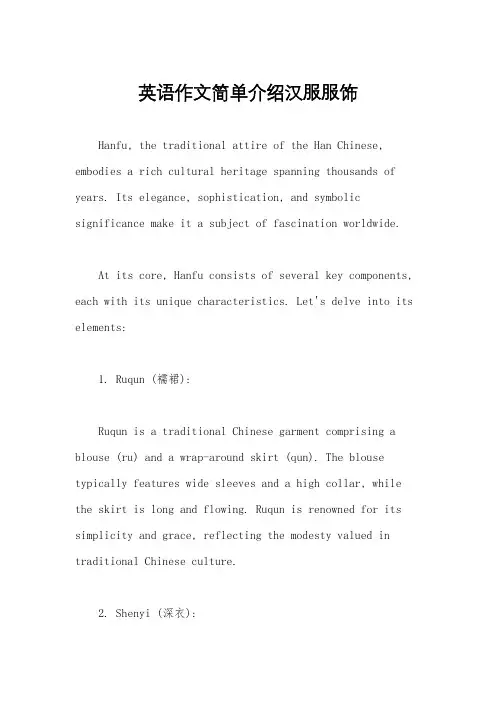
英语作文简单介绍汉服服饰Hanfu, the traditional attire of the Han Chinese, embodies a rich cultural heritage spanning thousands of years. Its elegance, sophistication, and symbolic significance make it a subject of fascination worldwide.At its core, Hanfu consists of several key components, each with its unique characteristics. Let's delve into its elements:1. Ruqun (襦裙):Ruqun is a traditional Chinese garment comprising a blouse (ru) and a wrap-around skirt (qun). The blouse typically features wide sleeves and a high collar, while the skirt is long and flowing. Ruqun is renowned for its simplicity and grace, reflecting the modesty valued in traditional Chinese culture.2. Shenyi (深衣):Shenyi is an ancient form of Han Chinese clothing that originated in the Shang Dynasty (c. 1600–1046 BCE). It consists of a cross-collar robe (yi) worn over a pleated skirt. Shenyi symbolizes the hierarchical structure of ancient Chinese society, with different variations worn by individuals of various social statuses.3. Zhongshan Zhuang (中山装):Zhongshan Zhuang, also known as the Zhongshan suit, is a modern adaptation of traditional Chinese attire. It features a high-collared, long-sleeved jacket paired with trousers, reflecting the influence of Western fashion during the early 20th century. Zhongshan Zhuang is often worn on formal occasions and has become a symbol of Chinese national identity.4. Quju (曲裾):Quju is a style of Han Chinese clothing characterized by its asymmetrical hemline, which forms a flowing curveknown as "water sleeve." This design element adds a senseof movement and dynamism to the garment, making it particularly suitable for ceremonial occasions such as weddings and festivals.5. Pibo (披帛):Pibo refers to the outer garments worn over the primary attire, such as robes, coats, and cloaks. These garmentsare often made from luxurious fabrics such as silk and satin, adorned with intricate embroidery and decorative patterns. Pibo not only provides warmth and protection but also serves as a means of expressing one's social statusand aesthetic taste.In addition to these main components, Hanfu may also include various accessories such as hair ornaments, jewelry, and footwear, each playing a role in completing the overall ensemble and adding personal flair.Overall, Hanfu represents more than just a form of dress; it encapsulates the essence of Chinese culture,embodying tradition, history, and artistic expression. As interest in Hanfu continues to grow both domestically and internationally, it serves as a bridge connecting the past with the present, preserving and celebrating China's rich cultural heritage for generations to come.。
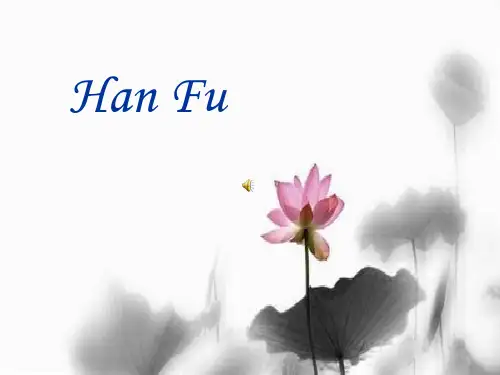
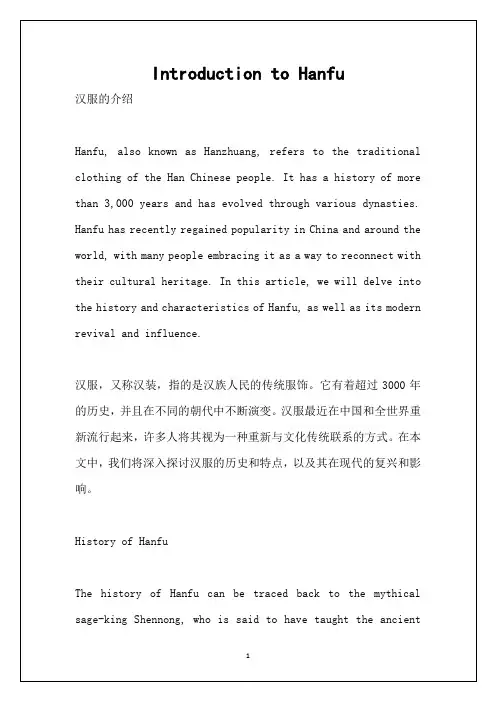
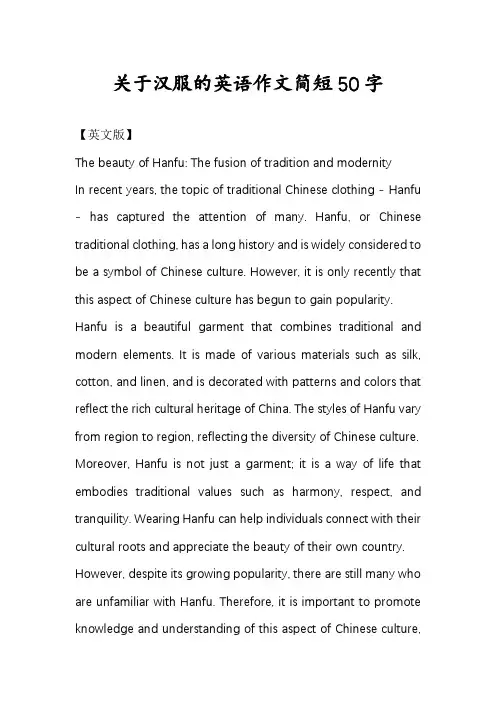
关于汉服的英语作文简短50字【英文版】The beauty of Hanfu: The fusion of tradition and modernityIn recent years, the topic of traditional Chinese clothing - Hanfu - has captured the attention of many. Hanfu, or Chinese traditional clothing, has a long history and is widely considered to be a symbol of Chinese culture. However, it is only recently that this aspect of Chinese culture has begun to gain popularity. Hanfu is a beautiful garment that combines traditional and modern elements. It is made of various materials such as silk, cotton, and linen, and is decorated with patterns and colors that reflect the rich cultural heritage of China. The styles of Hanfu vary from region to region, reflecting the diversity of Chinese culture. Moreover, Hanfu is not just a garment; it is a way of life that embodies traditional values such as harmony, respect, and tranquility. Wearing Hanfu can help individuals connect with their cultural roots and appreciate the beauty of their own country. However, despite its growing popularity, there are still many who are unfamiliar with Hanfu. Therefore, it is important to promote knowledge and understanding of this aspect of Chinese culture,so that it can be appreciated by a wider audience.【中文版】近年来,中国传统服饰——汉服的话题引起了众多关注。
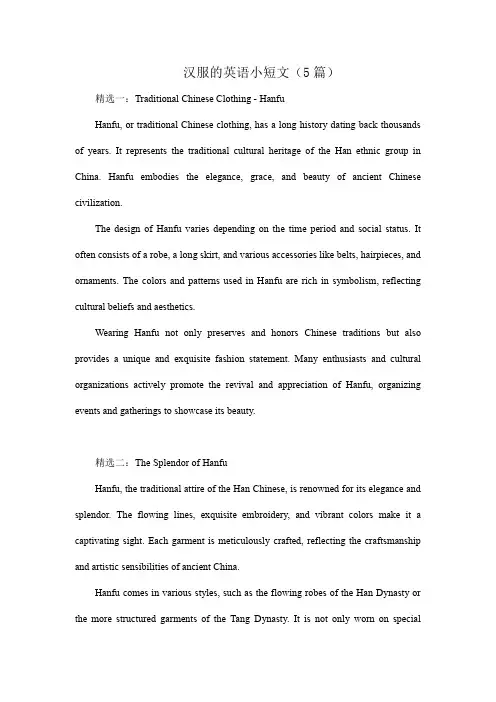
汉服的英语小短文(5篇)精选一:Traditional Chinese Clothing - HanfuHanfu, or traditional Chinese clothing, has a long history dating back thousands of years. It represents the traditional cultural heritage of the Han ethnic group in China. Hanfu embodies the elegance, grace, and beauty of ancient Chinese civilization.The design of Hanfu varies depending on the time period and social status. It often consists of a robe, a long skirt, and various accessories like belts, hairpieces, and ornaments. The colors and patterns used in Hanfu are rich in symbolism, reflecting cultural beliefs and aesthetics.Wearing Hanfu not only preserves and honors Chinese traditions but also provides a unique and exquisite fashion statement. Many enthusiasts and cultural organizations actively promote the revival and appreciation of Hanfu, organizing events and gatherings to showcase its beauty.精选二:The Splendor of HanfuHanfu, the traditional attire of the Han Chinese, is renowned for its elegance and splendor. The flowing lines, exquisite embroidery, and vibrant colors make it a captivating sight. Each garment is meticulously crafted, reflecting the craftsmanship and artistic sensibilities of ancient China.Hanfu comes in various styles, such as the flowing robes of the Han Dynasty or the more structured garments of the Tang Dynasty. It is not only worn on specialoccasions but also embraced by individuals as everyday attire, emphasizing the fusion of tradition and modernity.By wearing Hanfu, people not only connect with their cultural roots but also express their admiration for the timeless beauty and grace of traditional Chinese clothing. It is a way to appreciate the rich heritage of China and showcase its magnificence to the world.精选三:Hanfu and Cultural IdentityHanfu represents more than just clothing; it embodies the cultural identity and pride of the Han Chinese. It is a symbol of heritage and tradition, reminding people of their historical roots and the legacy passed down through generations.Through the revival and promotion of Hanfu, people seek to reconnect with their cultural heritage, fostering a sense of belonging and unity. It serves as a visual reminder of the profound history and contributions of the Han Chinese to Chinese civilization.Wearing Hanfu allows individuals to immerse themselves in the aesthetics and values of ancient China, showcasing the grace, modesty, and respect that were highly valued in traditional society. It is a way to preserve and celebrate the rich cultural diversity of China.精选四:Hanfu and Modern FashionIn recent years, Hanfu has gained popularity not only as a symbol of culturalheritage but also as a source of inspiration for modern fashion. Designers have incorporated elements of Hanfu into contemporary clothing, creating a fusion of traditional and modern styles.The beauty and elegance of Hanfu have captivated people worldwide, leading to its presence on international runways and in fashion magazines. This cross-cultural appreciation showcases the universal appeal of Hanfu and its ability to transcend time and boundaries.By integrating Hanfu into modern fashion, people are able to reinterpret and reinterpret traditional Chinese aesthetics, breathing new life into ancient traditions and bringing them into the contemporary world.精选五:Hanfu and Cultural ExchangeHanfu has become a medium for cultural exchange, promoting understanding and appreciation between different cultures. It serves as a bridge, connecting people from diverse backgrounds through a shared admiration for the beauty and cultural significance of traditional Chinese clothing.In international events and gatherings, individuals from various countries don Hanfu, immersing themselves in the elegance and charm of Chinese culture. This exchange not only fosters cultural appreciation but also promotes friendship and harmony among nations.Through the global popularity of Hanfu, traditional Chinese clothing has transcended national borders, becoming a symbol of cultural diversity and mutualrespect. It is a testament to the power of cultural exchange and the universal appeal of beauty and tradition.。
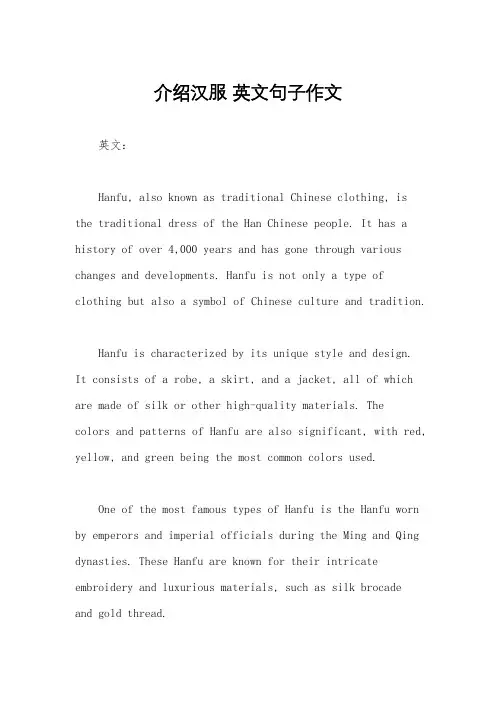
介绍汉服英文句子作文英文:Hanfu, also known as traditional Chinese clothing, isthe traditional dress of the Han Chinese people. It has a history of over 4,000 years and has gone through various changes and developments. Hanfu is not only a type of clothing but also a symbol of Chinese culture and tradition.Hanfu is characterized by its unique style and design.It consists of a robe, a skirt, and a jacket, all of which are made of silk or other high-quality materials. Thecolors and patterns of Hanfu are also significant, with red, yellow, and green being the most common colors used.One of the most famous types of Hanfu is the Hanfu worn by emperors and imperial officials during the Ming and Qing dynasties. These Hanfu are known for their intricate embroidery and luxurious materials, such as silk brocadeand gold thread.In recent years, there has been a resurgence ofinterest in Hanfu among young people in China. They wear it not only for special occasions but also as a way to connect with their cultural heritage and express their individuality.中文:汉服,也称为中国传统服饰,是汉族人民的传统服装。

中国汉服文化英文作文What is Hanfu?Hanfu is the traditional clothing of the Han Chinese people and refers to the clothing and accessories worn by the Han people from the Three Sovereigns and Five Emperors to the Beiyang government in China. Hanfu has a long history, reaching all the way back to around the year 2698 BC, and is still worn by many people today.What are the characteristics of Hanfu?Hanfu is characterized by its flowing robes, bright colors, and intricate designs. It is typically made from silk, cotton, or linen and is often decorated with embroidery, beading, or other embellishments. Hanfu is also typically worn with a variety of accessories, such as hats, shoes, and jewelry.What are the different types of Hanfu?There are many different types of Hanfu, each with its own unique style and purpose. Some of the most common types of Hanfu include:Ruqun: A type of Hanfu that was worn by women during the Han dynasty. It is characterized by its long, flowing skirt and short jacket.Shenyi: A type of Hanfu that was worn by men during the Han dynasty. It is characterized by its long, loose sleeves and wide collar.Beizi: A type of Hanfu that was worn by men during the Ming dynasty. It is characterized by its short jacket and loose trousers.Cheongsam: A type of Hanfu that was worn by women during the Qing dynasty. It is characterized by its long, fitted bodice and high collar.What are the benefits of wearing Hanfu?There are many benefits to wearing Hanfu, including:Promotes cultural identity: Wearing Hanfu can help people to connect with their Chinese heritage and culture.Boosts self-confidence: Wearing Hanfu can help peopleto feel more confident and proud of their cultural identity.Encourages creativity: Wearing Hanfu can encourage people to be more creative and expressive in their fashion choices.Provides a sense of comfort: Hanfu is typically made from natural materials, such as silk, cotton, or linen, which can provide a sense of comfort and relaxation.How can I get started with Hanfu?If you are interested in getting started with Hanfu, there are a few things you can do:Do some research: There are many resources available online and in libraries that can help you learn more about Hanfu.Find a community: There are many Hanfu communities around the world where you can meet other people who are interested in Hanfu.Purchase your first Hanfu: You can purchase Hanfu online or from a local retailer.Wearing Hanfu is a great way to connect with Chinese culture and heritage. It is also a fun and expressive way to express your personal style.汉服是什么?汉服,又称汉装、华服,是中国汉族人的传统服饰。
汉服英文作文介绍英文:Hanfu, also known as Han clothing, is the traditional clothing of the Han Chinese people. It has a history of over 4,000 years and is still popular among many Chinese people today. Hanfu is characterized by its loose, flowing style and intricate embroidery. It is often made from silk or other high-quality fabrics, and features a wide range of colors and patterns.One of the reasons why Hanfu is so popular is becauseit is seen as a symbol of Chinese culture and heritage. Many people believe that wearing Hanfu helps them to connect with their roots and feel a sense of pride in their Chinese identity. Additionally, Hanfu is often worn at important cultural events such as weddings and festivals, where it is seen as a sign of respect for tradition and history.Another reason why Hanfu is so beloved is because ofits versatility. There are many different styles of Hanfu, ranging from simple and elegant to elaborate and ornate. Some styles are more suitable for everyday wear, while others are reserved for special occasions. No matter whatthe occasion, there is a Hanfu style that is perfect for it.Overall, Hanfu is an important part of Chinese culture and heritage. It is a beautiful and versatile clothingstyle that has stood the test of time, and continues to be beloved by many Chinese people today.中文:汉服,又称汉装,是汉族人的传统服饰。
用英文介绍汉服推荐作文英文:As a fan of Chinese culture, I would like to recommend the traditional Chinese clothing, known as Hanfu. Hanfu, which literally means "Han clothing," refers to theclothing worn by the Han ethnic group in China during the Han dynasty (206 BC–220 AD) and other periods. It is characterized by its loose, flowing style, natural materials, and intricate embroidery.One reason I love Hanfu is that it is so comfortable to wear. The loose, flowing robes allow for plenty of movement, and the natural materials, such as silk and cotton, feelsoft and breathable against the skin. I also appreciate the attention to detail in the embroidery and other embellishments, which make each garment a work of art.Another reason to love Hanfu is its versatility. There are many different styles and designs to choose from,depending on the occasion and personal preference. For example, a simple, elegant robe might be worn for a formal event, while a more colorful and ornate outfit might beworn for a festive occasion like a wedding or holiday.One of my favorite things about Hanfu is how itconnects me to Chinese history and culture. When I wear Hanfu, I feel like I am part of a long and rich tradition, and I am proud to share that with others. It is also agreat conversation starter, as many people are curiousabout the clothing and its history.Overall, I highly recommend Hanfu to anyone who is interested in Chinese culture or just wants to try something new and beautiful. It is a wonderful way to connect with the past while also expressing oneself in the present.中文:作为一名中国文化爱好者,我想推荐传统的中国服装——汉服。
介绍中国汉服英文作文英文:Chinese Hanfu is a traditional clothing style that originated in the Han Dynasty and has been passed down for thousands of years. Hanfu is characterized by its loose and flowing design, with a focus on natural materials and elegant embroidery. It has a rich cultural and historical significance, and is still worn by many people in China today for special occasions such as weddings and festivals.One of the most unique aspects of Hanfu is the way it emphasizes the natural beauty of the wearer. The clothingis designed to be comfortable and flowing, allowing the wearer to move freely and express themselves. This is in contrast to many modern clothing styles, which often prioritize tight and restrictive designs that can be uncomfortable to wear.Another important aspect of Hanfu is its connection totraditional Chinese culture and history. Many of thedesigns and patterns used in Hanfu have deep symbolic meanings, and are often inspired by ancient artwork and literature. For example, the phoenix and dragon are common motifs in Hanfu, representing good fortune and prosperity.Overall, I believe that Chinese Hanfu is a beautifuland important part of Chinese culture. Its elegance and natural design make it a unique and timeless clothing style, and its connection to history and tradition give it aspecial significance that is hard to find in modern fashion.中文:中国汉服是一种起源于汉朝并流传了数千年的传统服饰。
中国传统文化汉服英语介绍《Chinese Traditional Culture: Hanfu》Chinese traditional culture is rich and diverse, encompassing various aspects of life, including clothing, language, art, and philosophy. Among these, one prominent aspect is the traditional clothing known as Hanfu, characterized by its elegance, beauty, and historical significance.Originating from the Han Dynasty (206 BC to 220 AD), Hanfu represents the traditional attire wornby the Han Chinese, the largest ethnic group in China. It was widely worn by men and women of various social statuses during the reign of the Han Dynasty and continued to be popular until the Ming Dynasty (1368 AD to 1644 AD).Hanfu features a unique design with a loose and flowing silhouette. It consists of several key components: the Zhongyi, a long gown worn as a top; the Ruqun, a skirt-like garment that is layered and worn as a bottom; and the Pifeng, a long silk cape worn over the Zhongyi. Hanfu reflects the traditional values of modesty, symmetry, and harmony, with intricate embroidery and exquisite details showcasing the craftsmanship of ancient artisans.The colors of Hanfu are traditionally rich and vibrant, with each color holding symbolic meanings. For example, the color yellow was reserved for the emperor, representing his sovereignty, while green was associated with nature and vegetation. Blue symbolized purity and wisdom, while red was for celebrations and festivities.Hanfu is not merely a historical costume but also a symbol of cultural identity and pride for the Chinese people. In recent years, there has been a resurgence in Hanfu's popularity, with more Chinese people embracing it as a form of cultural expression. Hanfu enthusiasts, both in China and around the world, gather at various events and activities to showcase their elaborate costumes and celebrate China's rich cultural heritage.Hanfu plays an essential role in promoting cultural exchange and understanding. It allows people from different backgrounds to appreciate Chinese history, aesthetics, and values. Furthermore, it serves as a reminder of the rich historical and artistic traditions that have shaped Chinese culture.In conclusion, Hanfu is an integral part of Chinese traditional culture. With its graceful design and symbolic meanings, it represents the elegance and beauty of China's past. By embracing and promoting Hanfu, the Chinese people aim to preserve and showcase their cultural heritage to the world, fostering a greater appreciation of their rich and diverse traditions.。
介绍汉服的英语作文_Introduce Hanfu 4篇导读:关于”介绍汉服“的英语作文模板4篇,作文题目:Introduce Hanfu。
以下是关于介绍汉服的小学英语模板,每篇作文均为万能模板带翻译。
关于”介绍汉服“的英语作文模板4篇,作文题目:Introduce Hanfu。
以下是关于介绍汉服的小学英语模板,每篇作文均为万能模板带翻译。
高分英语作文1:Introduce HanfuXuanduan is a dress made to order in Zhou Dynasty. It is dark black and has wide sleeves. It is only used in large-scale activities, such as sacrificial opera Costume: one piece fashion dress with one or several rings around the body, forming a unique style.During the Warring States period, it was cost-effective as a market dress, while in the Han Dynasty, it was regarded as a formal dress. Because some of its narrow lapels did not spread to later generations, it was often mistaken for the kimono Shenyi (long skirt): in the Warring States period, the clothing was worn by both men and women (different from the popular upper and lower garments, which were composed of cloth pieces), which symbolized that there were several months in a year, and there was no fashion at that time It was passed down, but it was made into men's formal straight dress (straight dress) in the Ming Dynasty: through cutting men's clothes, fastening them with a belt or corset collar, and using a piece of cloth to form a lower garment, in the Ming Dynasty, it was usually made into a men's dress of togaz clergy,which was cut and made into a style of pendulum skirt with dark knees: Women's dress, such as a Katy Sark, while a group was a skirt Half sleeve women's upper garment, with sleeves similar to the current short sleeve open-ended skirt of Tang Dynasty style, similar to the general Ruqun, but tied on the chest, with Kezi and Chinese style jacket, Hanfefers to its style, front open collar jacket: Women's jacket of Tang Dynasty, not the common cross collar of Han Dynasty, but the open-ended horse face group not popular after the Tang Dynasty: a skirt of Ming Dynasty, with It has a rather gorgeous pendulum style: a cloak, as men's and women's clothes, Duanda (short clothes): the casual clothes of the working people, Chinese jacket and trousers, the jacket has a slit on both sides, and the sleeves are narrow, which is very convenient for labor. It can be used as casual clothes and household underwear: men wear underpants and pants, women wear underpants, and men must wear Zhongdan, and wear a white robe on their underwear.When people wear clothes, Han clothes without underwear are considered impolite, just as people wear suits without shirts.中文翻译:玄端为周代定做的礼服深黑色,袖子很宽,只在大型活动中使用,如祭品曲剧服:一件式的时装,在身体周围戴一个或几个环子,形成独特的风格。
Dress culture is introduced服饰文化介绍Hanfu clothing is the traditional clothing of the Han Chinese(Han -the predominant ethnic group of China).汉服是中国汉民族传统服饰。
It's the significant cultural symbol of Chinese civilization, and it has had a long history for nearly 4000 years since China originally began.她从中华文明开端时就已经存在,至今已有近4000年的历史。
(当然如果你喜欢你可以说成5000)However, it has been eliminated during the establishment of Qing Dynasty (the Manchu minority ruled dynasty) in about 300 years. The ruling class of Manchu banned Han Chinese clothing and replaced it with their own costume. This is why today's Chinese national costume was widely known as Qipao (Chi-Pao), a Manchu style of clothing. Our effort is to re-promote and advocate Hanfu to the public awareness.The main feature of Hanfu is wrapping the right side over before the left.There are casual wear and formal wear of it.汉服的主要特点是交领右衽,包含礼服和常服两种。
For the casual wear such as Shenyi (Shen-Yee): a long full body garment; Ruqun (Zu-Chin): a top garment with a separate lower skirt, etc. Formal garments may include: Xuanduan (Shyan-Duan): a dark robe, this dress is mostly used in sacrificial ceremonies and state occasions; Yuan-Lin Shan: a closed, round collared robe, mostly used for official or academic occasions.Chinese civilization, also called "Hua-Xia" ("Hwa-Shia"). "Hua"("Hwa") means the beauty of the dress & decoration which is Hanfu clothing; "Xia"("Shia") is the grandeur of rites and social conduct.中华文明又被称为“华夏”,华代表服饰之美,夏代表礼仪之大。
Many East Asian national costumes, such as the Japanese Kimono, the Korean Hanbok still share the basic style with Hanfu,as historically these nations were largely influenced by (Han) Chinese culture.东亚许多民族的传统服饰,比如日本的和服、韩国的韩服,都是在汉服的基础上发展而来。
Costume in the Han Dynasty汉服China's complete code of costume and trappings was established in the Han Dynasty (206BC-220AD). The yarn-dyeing, embroidering and metal-processing technologiesdeveloped rapidly in the period, s中国完整的服装服饰制度在汉朝确立的。
汉代染织工艺、剌绣工艺和金属工艺发展较快,推动了服装装饰的变化。
purring changes in costume and adornments.汉时劳动女子总是上穿短襦,下穿长裙,膝上装饰长长垂下的腰带。
劳动男子常服是上身穿襦,下身穿犊鼻裤,并在衣外围罩布裙;这种装束不分工奴、农奴、商贾、士人都一样。
The costume code of the Western Han Dynasty (206BC-8AD) followed the one established in the Qin Dynasty (221-206 BC). In the Eastern Han Dynasty, people in black had to wear purple silk adornments to match their clothes. People usually wore costume with a long hat at grand ceremonies offering sacrifices to gods or ancestors. The dress of the queen in these ceremonies consisted of dark-purple frock and black trousers. The silk dress of the queen consisted of cyan frock and buff trousers.西汉建立时基本上沿用秦朝的服制。
东汉时期穿黑色衣服必配紫色丝织的装饰物。
祭祀大典上通用的是“长冠服”。
皇后的祭祀服是:上衣用绀色,下裳用皂色。
皇后的蚕服,上衣用青色,下裳用缥色(浅黄色)。
汉文帝当政时比较俭朴,自己穿黑色丝织衣、皮鞋。
一般官员要穿禅衣,又名“祗服”。
The Western Han Dynasty implemented the Shenyi (long coat) system, which featured a cicada-shaped hat, red clothes and "田"-shaped collar. In addition, people of that time wore jade articles and red shoes. The frock and skirt were sewn together in the Shenyi system. Underpants for memorial ceremonies were decorated with black brims, and those for court dress in feudal China were decorated with red brims. All the garments were collectively called as Chanyi (unlined garment).在西汉时期二百年之中,服饰实行“深衣制”,它的特点是象蝉一样的头冠(帽子)、红色的衣服、象田字状的领子、戴玉、红色的鞋。
深衣形制是上衣下裳相连接缝在一起,做祭服的中衣,要缘黑色边,作为朝服的中衣,需缘红色边,当时男女服用极为普遍。
服饰总称“禅衣”。
禅衣是单层的外衣。
禅衣里面有中衣、深衣,其形与禅衣无大区别,只是袖形有变化,都属于单层布帛衣裳。
官员在上朝时都要穿黑色禅衣。
Costumes in the Han Dynasty fell into two categories according to Yijin (one or two pieces making up the front of a Chinese jacket or grown). There were two types of garments: the curving-front unlined garment with buttons deviously down from the collar to the axilla; the straight-front unlined garment with buttons were straightly down from the collar to the lower part. Curving-front garment originated from the Shenyi (long coat) prevalent in the Warring States Period, and was still in use in the Han Dynasty. But few people wore the Shenyi garments during the Eastern Han Dynasty.汉衣款式以衣襟分类,可以划分两种:一为“曲裾禅衣”,即开襟是从领曲斜至腋下;一为直裾禅衣,是开襟从领向下垂直,此种禅衣又称“”。
曲裾,即为战国时期流行的深衣。
汉代仍然沿用,到东汉,男子穿深衣的已经不多了,一般为直裾衣,但并不能作为正式礼服。
这种服式既长又宽,从款式上官民服用基本没有差别,但从原料和颜色上,却可明显显示等级的不同。
There were specific stipulations on colors of court garments in the Han Dynasty. Officers must wear garments according to the five time periods, i.e. cyan garments in the spring, red in the first two months of the summer, yellow in the last month of the summer, white in the autumn and black in the winter.汉代朝服的服色有具体规定,一年四季按五时着服,即春季用青色;夏季用红色;季夏用黄色;秋季用白色;冬季用黑色。